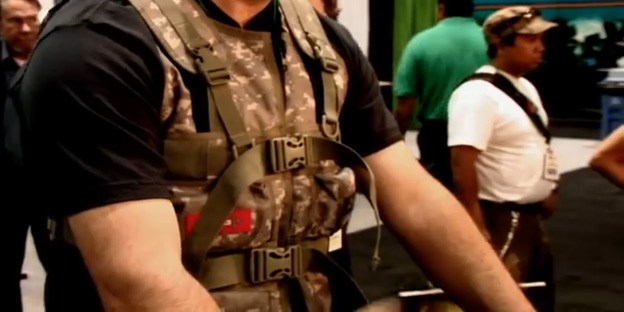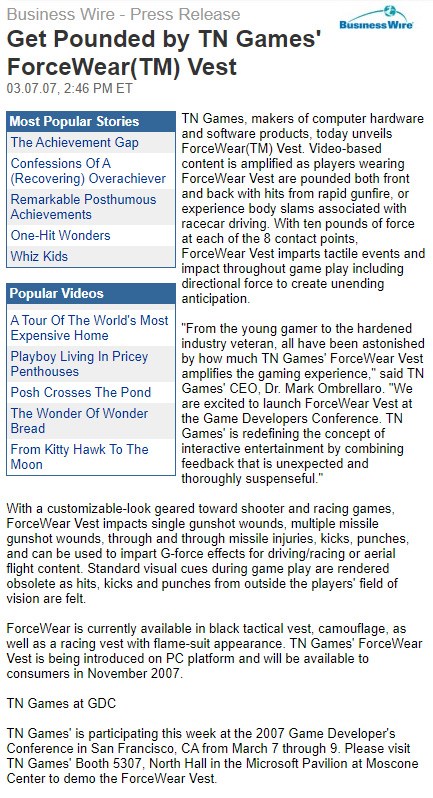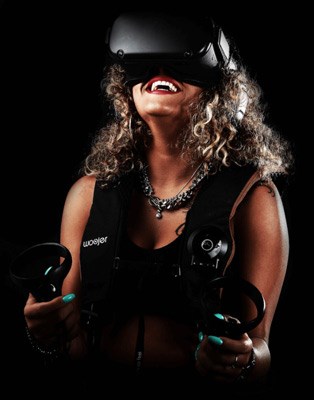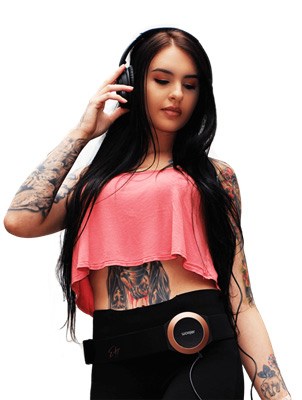There’s nothing wrong with living in a fantasy world. Fans of the smash hit novel and subsequent movie, Ready Player One, will all tell you “We already have this technology!” citing crowdfunded haptic VR suits and VR treadmills. But how close are we to mainstream fully immersive VR gaming?
Are we ready to enter The Oasis and subsequently spend all our time living in a world of virtual gaming, only popping out for the occasional protein bar and to make the kids their packed lunch? Do we have haptic VR suits that will enable us to feel every punch, kick and shotgun blast? Can we run around on the spot with a VR treadmill, performing roundhouse kicks in the heat of combat? The answer is yes… and no.
What is Haptic Feedback?
Before we get too deep into things, it would be helpful to explain what haptic feedback actually is. I actually remember playing on my PC one evening back in 2007 and hearing my email ping. My best friend had sent me an article concerning the ForceWear 3rd Space Vest, unveiled at the Game Developers Conference in San Francisco. It looked like a Kevlar vest you might see a soldier wearing in combat. It wasn’t some big plasticky thing you strapped to yourself, not at all, it actually looked like a tactical piece of equipment. My gaming world shook.

The vest could be worn by the player, and according to Forbes (article screenshot below) impacts single gunshot wounds, multiple missile gunshot wounds, through and through missile injuries, kicks, punches, and can be used to impart G-force effects for driving/racing or aerial flight content
. Now, imagine my surprise when I learned a company had begun making a product that I had discussed with my gaming friends in the pub. After all, we had worked out the kinks ourselves, likening the technology to the rumble packs, DualShock controllers and other force feedback products already available in controllers and steering wheels. It wouldn’t be too much of a stretch to imagine smarter minds than ours making a suit or vest that had similar tech built into it. We speculated that modders were probably already working on something anyway.

It was pretty simple tech: when the player gets shot in the back, one of the eight contact points in the vest would activate and provide the feeling of impact, letting the player know they should probably turn around and dispense with their enemy. Imagine the vibrations you feel in your phone or Xbox controller but strapped to your body using a vest or suit. They all utilise a somewhat staple type of vibrotactile haptic feedback, where small motors are used to simulate the feeling of touch through vibrations.
TN Games, the makers of the 3rd Space ForceWear Vest (and still active in the market), were naturally met with resounding approval at the GDC, and the company’s CEO, Dr. Mark Ombrellaro, noted From the young gamer to the hardened industry veteran, all have been astonished by how much TN Games' ForceWear Vest amplifies the gaming experience,
So, then, these were probably the humble beginnings of haptic feedback, where a player’s actions in a game could be brought to life and fully immerse them in their favourite shooter, driving sim or flight sim.
Other companies soon revealed their response to TN Games. Since 2013, there have been numerous endeavours in the pursuit of plugging a player into their favourite game and truly feeling immersed, from simple gloves to full body suits.
Haptic VR Vest
If you want true immersion into virtual worlds, then a full body suit is the way to do it. However, it’s not always possible to slip into your gaming suit and hook up to a PC when you’re on your lunchbreak, so a vest is the next best thing. There are a few companies to look out for in this arena.
bHaptics
There have been some amazing leaps forward with this technology, and if you have spent any time looking into VR haptics, a company called bHaptics will definitely have been in the top results.
The bHaptics TactSuit X40 is great to look at and with an immense 40 haptic points, is clearly an improvement on the early iterations of this tech. Using Bluetooth technology for low latency feedback, and allowing a fully wireless experience with up to 18 hours of play time, the TactSuit X40 is perfect for high-end VR gamers. Beside the TactSuit X40, bHaptics also make the TactSuit X16, which has 16 vibro-tactile motors, the same Bluetooth technology, and up to 22 hours wireless play time.
bHaptics also make various other devices that can be used on your head, hands, arms and feet, exponentially expanding the realms of VR haptic feedback. To put it in real terms, you’re able to feel a headshot from a sniper, the impact of a punch on your hand when you hit a boxing opponent, or a gut shot from a shotgun in a high noon shootout.
They also provide a helpful list of bHaptics compatible games. Here, we must pause for a moment, because I spotted one of my favourite games on the Oculus Quest 2: Thrill of the Fight.
As a huge fan of this already immersive boxing game in VR, I was amazed when I watched the demo and saw the player able to feel a punch to the face, and then one to the body. Thrill of the Fight has been directly responsible for most of my weight loss during the 2020 lockdown, and I can only imagine racking up many more hours in this game if I can feel and deal the damage.
Immersion is the key word here, and bHaptics just get it. They know that gamers don’t just want to feel the bullets hit their body, but they also want to feel a backpack being taken off their character, or the feel of branches hitting their body as they meander through a dense jungle. In practicality, however, the games have to actually be modded or designed for this type of feedback, meaning the road ahead is still being paved for VR haptic feedback.
Woojer
With only 6 “patented, powerful, accurate, polyphonic & silent Osci™ haptic transducers” the Woojer Vest Edge might be seen as a poor substitute for the bHaptics vests. Rather than providing haptic feedback in the same way bHaptics vests do, Woojer have opted to respond to sound. Woojer have, therefore, been gaining a strong footing in the marketplace by currying favour with gamers who specifically want the sound of a game to provide feedback. Games like Beat Saber and other synth riders already have a massive following and hardcore fanbase, and will provide a market sector of their own for such companies.


Woojer manufacture the Vest Edge and Strap Edge. The former being a vest-type device that looks more like you’re wearing a rucksack, and the latter being a strap you can wear around your waist, chest or even cross-body. The Strap Edge is quite unique in that – as a haptic device – it is pitched at music lovers and fitness enthusiasts as a way to enhance their listening pleasure or upgrade their gym session.
The Vest Edge is aimed squarely at gamers, it appears, but the company have also had lots of feedback (pardon the pun) from reviewers that suggest watching movies, listening to music and gaming are all perfect use cases.
Other Haptic VR Devices
Remember, this technology is still in its infancy, but companies are usually driven by passionate gamers or extremely determined indie start-ups, so you can always expect the unexpected. Don’t forget, also, that Oculus Rift was a 2016 Kickstarter that blew up beyond all expectations before Facebook got their claws in. We’ve seen futuristic looking haptic guns and all kinds of wearables, so there’s plenty of creative thinking going on. We can expect more in this arena, but for now, these are some devices to keep your crosshairs on…
TESLASUIT
The Teslasuit was named a CES 2019 Innovation Awards Honoree in Virtual and Augmented Reality. This full-body haptic suit enhances a VR and AR experience using haptics, biometry and motion tracking. The Teslasuit has been developed by designers, engineers, programmers, medical professionals and AR specialists, creating a “smart textile” full bodysuit that is little more than a pretty snazzy-looking jacket and trousers to the untrained eye.
The suit inputs haptic feedback to any area of the body, from a gentle touch, to feelings of physical exertion and temperature, and outputs motion capture and biometrics. Such an innovative approach to XR training increases information retention and engagement through experiential learning techniques.
TESLASUIT provides deeper sensory immersion in VR and AR environments, enabling users to safely experience stressful, hazardous scenarios as though they’ve lived them. It allows companies to decrease operational costs by millions of dollars.
Easily the most exciting product in VR for some time, the Teslasuit looks the part, and has the scientific backstory that will ensure it finds buyers in the marketplace – regardless of cost. Whilst the possibilities are incredible for gaming, their product also lends itself to many other applications, including being used in athletics training, in rehabilitation usage, and of course real world experiences in enterprise situations.
The aim of Teslasuit is to make digital worlds come to life in many more ways than the pragmatic; such as feeling rain on your shoulders in the Amazon jungle or an elephant’s trunk on your shoulder as you take a tour of India. These types of consumer experiences in VR are creeping much closer with products like Teslasuit, and the tireless work of developers that make it possible.
Kat-VR
As far as places to work go, one can only imagine the fun this company has in testing their products. Kat-VR have staked their claim in the VR device space by demonstrating that their products are as close to fiction as you can get.
The KAT loco S is a “walk on the spot” device that will tell the VR game you’re playing where you’re walking and how you’re moving. Demos of the KAT loco S being used with games like Half-Life Alyx and Boneworks have already made the rounds and look great.
Their KAT Walk treadmill range enable the player to walk through their gaming worlds by using a slippery surface (combined with a harness) which reacts to movement and pressure, conveying directional and speed data to the game. This looks pretty darn close to what our heroes in Ready Player One were doing, and when combined with other haptic devices blur the lines of reality.
Interestingly, the way this type of technology combats issues like motion sickness is also a fantastic selling point. Where zooming to a point in the distance or walking using thumbsticks can cause some people to react badly, walking on a treadmill offers a much more intuitive experience.
NextMind Brain-Computer Interface
Whilst this company’s vision and missions statement might worry some science fiction fans, it is exciting nevertheless. NextMind hope to create a telepathic link between the player and the game, by strapping on their NextMind Sensor. This brain-sensing wearable with an adjustable headband







